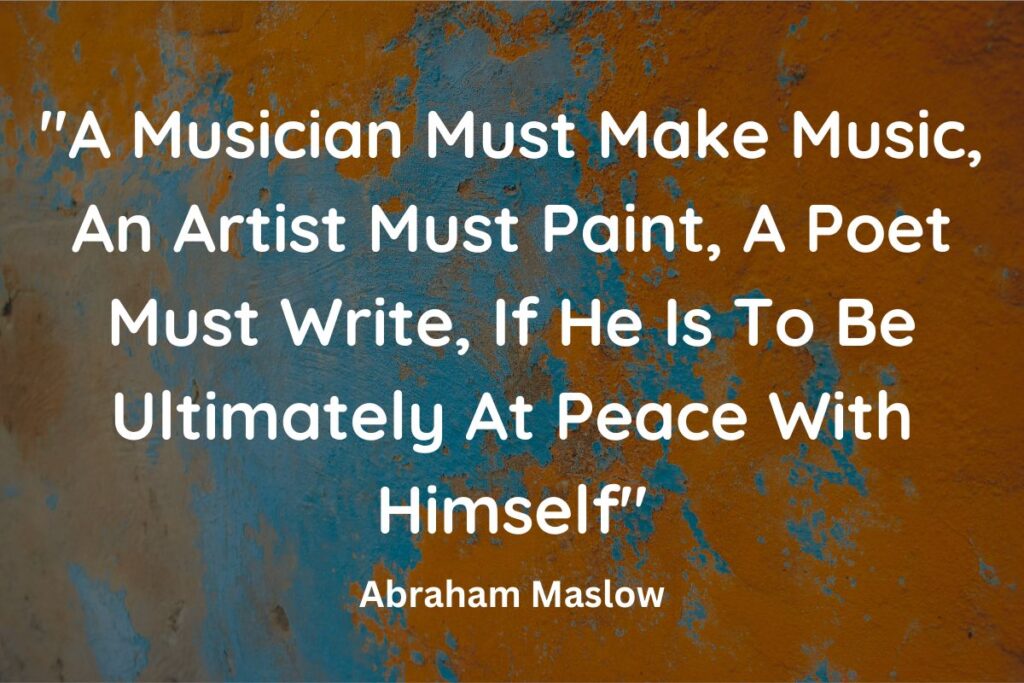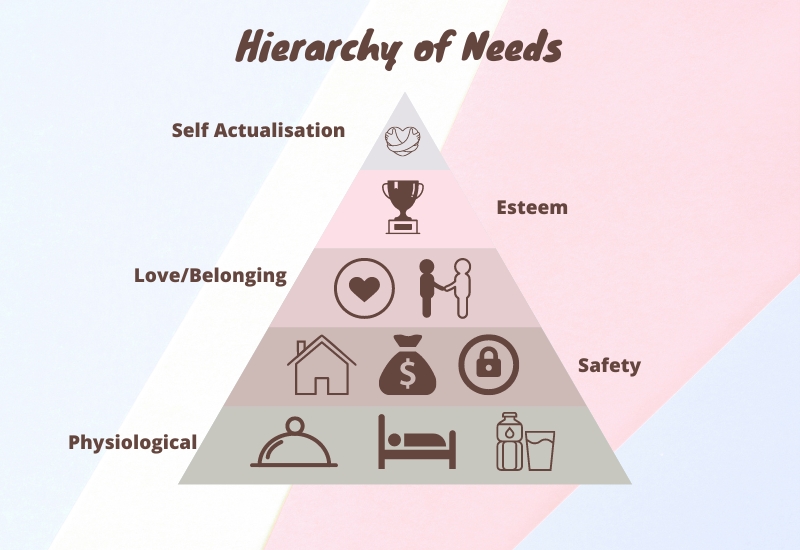When it comes to the best theories of motivation that thoroughly tell and assist people about people’s behavior, Maslow’s hierarchy of needs psychology would definitely be in it. It is Abraham Maslow’s theory, which clearly states that every person gets motivated by his physiological, psychological, and other needs and acts according to them. Let’s discuss in detail what the Abraham Maslow Hierarchy of Needs is.
What is Maslow’s Hierarchy of Needs Theory?
Maslow’s hierarchy of needs definition:
“A motivational theory called Marlow’s hierarchy of needs explains how certain wants must be satisfied for people to attain their maximum potential. The hierarchy of needs places the most fundamental requirements at the bottom and the most sophisticated demands at the top.”
Maslow’s hierarchy of needs is a generally accepted theory of psychology that explains human motivation by identifying different levels of needs that people strive to fulfill. According to the theory, humans are motivated to fulfill their needs in a specific order, with the most basic needs taking precedence over more advanced needs.
Physiological needs, such as food and shelter, are considered to be the most basic and must be met before an individual can move on to fulfilling higher-level needs. As individuals satisfy their requirements at one level, they become motivated to fulfill the next level of needs. It is considered as one of the most influential psychological theories of human motivation.
Abraham Maslow’s Hierarchy Of Needs – A Peek Into Its History
A paper with the title “A Theory of Human Motivation,” was the first paper that contained the concept of a hierarchy of needs. This theory was introduced by Abraham Maslow, who was an American psychologist, in 1943. Again in 1954, in a book titled “Motivation and Personality,” he further enhanced the theory and proposed five core needs that motivate and shape human behavior and make him or, in another sense, compel him to act in a certain way (in a positive sense).
This theory proposed that every person’s decision-making power is controlled by their desires. It differs from psychoanalysis and behaviorism, which focused on the unconscious mind and problematic behaviors and was widely accepted then. Maslow had a different aim; he wanted to learn about human happiness, its reasons, and how to achieve it.
Maslow is a humanist, and that’s why he focused on the belief that humans are and must be free to give their lives meaning, value, and purpose. He believed that every human being has an inborn desire for self-actualization. But, according to him, self-actualization is a person’s need. It is only achieved when he wins other requirements like the basic ones, safety, love and relationships, and self-esteem. The desire for these needs is the ultimate reason which motivates a person to do something to achieve them.
Deficiency Needs Vs Growth Needs
According to Maslow’s hierarchy of needs, there are five types of needs, and that’s why he presented his theory as a pyramid with five stages. But overall, Maslow has divided these needs into two categories;
Deficiency needs (D-needs):
It contains the first four stages from the bottom side of the pyramid. As its name suggests, these needs arise because of their lack of presence and deprivation. These needs compel a person to achieve them because if a person can’t reach them, he has to face severe consequences regarding mental health. The urge for these needs increases until the person achieves them, just like a person’s thirst increases without water.
Growth needs (being needs or B-needs):
It contains the highest stage of the pyramid, and its name suggests that these needs emerge from a person’s desire to grow in a positive way. You can call them wishes, and a person can desire them, but these do not appear as a deficiency needs or due to the unavailability of something. And if a person achieves his growth needs, he will achieve self-actualization.
According to Maslow, the model doesn’t suggest that a person can’t progress in this model until the first need is 100% satisfied. Even though he believes that the urge for deficiency needs to increase until it can’t be satisfied but urge for growth needs to increase once a person achieves it.

Abraham Maslow Hierarchy of needs – 5 Level Pyramid
Maslow’s hierarchy of needs is presented as a pyramid with 5 stages. Though the needs are divided into two categories depending upon their nature of urge, which I mentioned above, the pyramid contains five different types of needs. You can call it the collection of any person’s life needs. What are the 5 levels of Maslow hierarchy of needs? To know about it, keep reading.
Physiological Needs
The pyramid’s base has physiological needs, which contain the basic things every person needs to survive in the world. Some of them are mentioned below.
- Air
- Water
- Food
- Shelter
- Sleep
- Clothing
- Homeostasis
- Reproduction (somehow)
The foundation of human needs starts with fulfilling basic physiological requirements like nutrition, air, and temperature regulation. However, it’s not just about meeting these necessities; having access to shelter and clothing is also critical in ensuring one’s survival. Maslow believed that sexual reproduction also falls under this category, recognizing its significance in preserving the survival and perpetuation of the species.
Security & Safety Needs
Then comes the complex needs, the safety and security ones. In addition to controlling their lives, people are also concerned about the security needs like
- Physical safety and security (e.g., protection from harm and threats)
- Financial security (e.g., stable income, access to resources)
- Health and well-being (e.g., access to healthcare, clean water, and food)
- Personal safety (e.g., protection from discrimination, abuse, or violence)
- Job security (e.g., stable employment)
- Political stability (e.g., protection of a person’s freedoms and rights)
The second level of Maslow’s hierarchy of needs, which encompasses safety and security needs, drives individuals to take actions aimed at fulfilling these needs. These actions can include:
- Seeking stable employment or financial security
- Working to protect their physical safety and well-being through self-care or seeking medical attention
- Seeking out safe and secure living arrangements
- Protecting their security and freedom through advocacy or activism
- Supporting political systems and policies that ensure personal security and safety
Social Needs
Social needs are also called belonging, and love needs. Emotional needs like love, acceptance, relationships, or belonging are the primary drivers of human behavior. The need for love and companionship can be satisfied through a wide spectrum of social connections, including close relationships with friends and romantic partners, as well as intense family bonds.
The fulfillment of this need helps people to avoid or defeat mental illnesses like depression and anxiety; people no more feel lonely. Not only loved by individuals, but people also feel good when loved and accepted by groups like physical games groups, book clubs, music groups, religious groups, and other social groups.
Esteem Needs
Maslow’s hierarchy of needs includes esteem needs as the fourth level. These needs refer to a person’s desire for self-esteem, self-respect, and recognition from others. They have things such as status, achievement, self-confidence, and independence. Once lower-level needs like physiological, safety, and social needs are met, individuals will seek to fulfill their esteem needs through accomplishments, recognition, and respect from others. These needs help to form a person’s sense of self-worth and identity.
Self-Actualization Needs
This need took the hierarchy’s top place. It refers to a person’s realization of his true potential and becoming self-aware. He tries to figure out his deep desires, seeks personal growth, puts other people’s opinions aside, and focuses on himself. In 1943, Maslow described this level as the aim for self-actualization, where a person strives to achieve his/her full potential and become his/her desired self and the best he/she can be. The drive centers on personal growth and the aspiration to reach maximum potential.
Maslow’s Hierarchy Of Needs Pyramid – 8 level Pyramid
In the year 1970, Maslow made an addition of three needs in the growth category of the pyramid keeping the deficiency needs category the same. So, the extended model of the hierarchy of needs contains a total of eight types of needs, and the additional three are.
Cognitive needs
Maslow places cognitive needs at the bottom of growth needs. Maslow’s hierarchy of needs recognizes the importance of cognitive needs, which center on knowledge and understanding of the world and one’s place in it.
It includes a drive for exploration, curiosity, the need for meaning and predictability, and the desire for growth and self-actualization through learning and problem-solving.
As people desire to understand things and solve mysteries, Maslow believed that if cognitive needs get blocked, all other needs will not be achieved.
Aesthetic needs
Aesthetic needs in Maslow’s hierarchy of needs refer to the desire for balance, beauty, and order in one’s surroundings and life experiences. And this includes appreciation for and participation in activities such as art, nature, and creative expression. Moreover, the search for meaningful experiences and a sense of fulfillment through creativity and self-expression is also included in it. It is considered a higher level of human motivation, satisfied after physiological and safety needs are met.
Transcendence needs
Transcendence needs to take over the pyramid’s highest place or peak point. In other words, it is considered at the last of Maslow’s hierarchy of needs in order. The name transcendence suggests that this needs demands a person look beyond their normal and physical self. Maslow was a believer in the fact that the human inner self demands transcendence needs. A person can practice spirituality, spend time with nature and connect with it, and help people around him can help him to achieve this need.
Work Process Of Maslow’s Hierarchy Of Needs Model
Unlike other psychological theories, Maslow’s hierarchy theory is not rigid. Maslow himself believed that despite the factors that a pyramid demands, a person starts from the bottom and achieves the needs step by step in the upward direction; the work process doesn’t work the same for every human being. It’s just a myth that a person should fulfill the first need and then step on the second because it depends upon a person’s preference of which need he thinks is the most important.
For example, one person needs family love, another needs a job immediately, one needs confidence, and the other needs health. So, in each case, the positioning of the deficiency needs would change according to the preferences.
Moreover, Masllow’s hierarchy of needs is not a uni-directional model, so it doesn’t mean that if a person fulfills the first need, he will never return to it; instead, he states that a person always moves back and forth between the deficiency needs.
Despite the urge for self-actualization, life experiences like losing some close ones, jobs, divorce, discrimination, any insulting happening, etc., disturb the pyramid and make a person tangled in these needs. Thus he continuously fluctuates between these needs.
However, the urge for self-actualization is completed by people after successfully achieving their deficiency needs.
Conclusion
The five levels of Maslow’s hierarchy of needs are explained in detail here. They are motivational triggers and can make a person able to try and fulfill their needs. Though people move like a pendulum between these needs, those who achieve all of the basic needs can win self-actualization needs.















